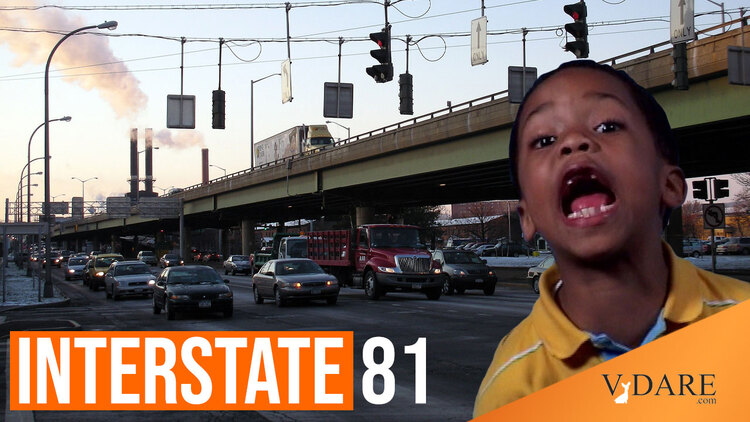


By Steve Sailer
06/06/2023
Earlier: The Asian In The Living Room … . Who Owns The Black Store
From The New York Times news section:
Why It’s So Hard to Tear Down a Crumbling Highway Nearly Everyone Hates
The Interstate 81 viaduct in Syracuse effectively destroyed a Black neighborhood when it was built, and it has been falling apart ever since. But getting rid of it is complicated.
By Jim Zarroli
June 3, 2023These days, hardly anyone in Syracuse sees the hulking Interstate 81 viaduct as anything but a menace, an ugly 1.4-mile overpass that spews noise and pollution and has steadily worsened race relations in the city.
So when the New York State Department of Transportation finally decided in 2019 that the crumbling roadway should be torn down and replaced with a pedestrian-friendly boulevard, the kind of project that’s helped rejuvenate other American cities, a lot of people were excited.
“It sounds crazy, but this project will hopefully be one of the most transformative things to happen in this region in a hundred years,” said Joe Driscoll, who left his position on the Syracuse Common Council in 2022 when the city offered him a job as project director for the viaduct’s removal.
But actually demolishing a highway that nearly everyone seems to hate has proved more complicated than expected.
Part of this stems from the fact that the area primarily affected is Syracuse’s 15th Ward, a historically Black neighborhood that abuts the highway and has long borne the brunt of its impact. Residents in the 15th Ward, despite the promise of the new development, are wary of gentrification and further disruption. But city planners have also faced a string of legal challenges from suburban communities that say the viaduct’s removal will harm businesses outside the city.
… Today, fewer and fewer people are alive who can remember the neighborhood in its heyday, when its streets were home to flourishing restaurants, barber shops and clothing stores, some of them Black-owned.
After World War II, large numbers of African Americans came to Syracuse to work in factories such as Carrier, the air-conditioning manufacturer. Virtually all of them moved to the 15th Ward, a sliver of a neighborhood between downtown and University Hill, home to many of the city’s colleges and hospitals. They did so largely because restrictive covenants barred Black people from buying or renting elsewhere in the city, according to Kishi Animashaun Ducre, the associate dean for diversity, equity and inclusion at Syracuse University, who has studied housing patterns in the city.
But within the 15th Ward, life could still be sweet, recalled Clarence Dunham, who grew up there and has seen the changes first hand. “In Syracuse, the Black neighborhood was very small,” Mr. Dunham recalled. “Most of the families knew everybody. If they didn’t know you, their grandparents did. Or they knew your mother, your father, your uncles. It was very tight-knit, and it was lovely.”
In other words the black community in Syracuse wasn’t very big and was composed of hard-working ambitious people. But then its quantity exploded and its quality declined as poor Southern blacks poured in after the state of New York boosted welfare in 1961.
Here’s the umpteenth article I’ve read about how a Racist Road destroyed a thriving black neighborhood in 1956-1966. But where now are the thriving black neighborhoods that were spared? Every city has its own excuse for the collapse of its black districts.
Rather than attributing each and every black business district’s demise to some specific 1960s local urban renewal project, isn’t it more likely the national cause was that lower-class blacks became more numerous and criminal in Northern cities and middle-class blacks could move out?
Also, middle-class blacks during the Civil Rights era often switched from being small businessmen in the black business district to middle managers in corporations and government. Thus black neighborhoods today often have nice residential streets but bad commercial streets.
African-Americans since the 1960s just aren’t that interested in small business. I can recall being shocked in 1990 to discover that in Chicago, owning a retail shop selling black hair care products, once the prototypical black business, was now dominated by Korean immigrants.
And it must have been discouraging for African-Americans who wanted to own a small business in their own neighborhood, normally a reasonable and respectable ambition, to be crushed by workaholic Koreans with 110 IQs who’d come 10,000 miles to run a dry cleaner in the ‘hood.
Is there today a thriving non-immigrant black business district in urban America? I know of quite nice black residential neighborhoods, such as View Park–Windsor Hills in L.A., but I’m drawing a blank on today’s black commercial sectors to rival Harlem in Charlie Parker’s day.
Magic Johnson made some money in the late 1990s bringing Starbucks and a movie theatre to the commercial streets near the best black neighborhoods south of Beverly Hills, but they’ve been pretty marginal since 2008.